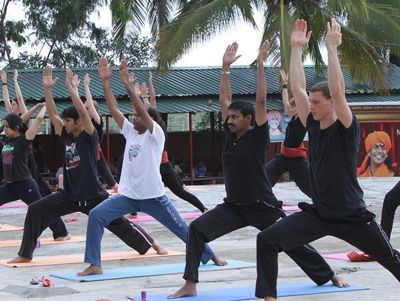The Nithya Yoga practice is a beautifully structured 60-minute class that includes most traditional yogic practices including postures (asana), breath control techniques (pranayama), stylised hand gestures (mudras), relaxation, rejuvenation (shivasana) and deep meditation (dhyana).
A typical class consists of nine components designed to help the student experience the space of Nithya Yoga, that is, eternal uniting, moment to moment. These nine components of a class are:
Centering Meditations (Pantanjali Dhyaan and Breath Awareness)
At the beginning of every Nithya Yoga class, students practice three minutes of Patanjali Dhyaan, a dynamic meditation which prepares students to centre themselves through intense movement and shaking of every part of the body. Patanjali Dhyaan energizes the body and mind, warms the body and loosens the muscles. Most importantly, it removes lethargy and restlessness of the body-mind. This simple technique brings intense awareness and helps the student to be totally and completely anchored in the body.
Following Patanjali Dhyaan, students sit in a comfortable posture and bring their awareness into their breath. The practice of breath awareness anchors the mind and dramatically reduces the frequency of thoughts. In this relaxed space, the student can more easily set their intention for the session with depth and clarity.
Intention
Students are encouraged to create an intention for their practice at the beginning of a session. In Nithya Yoga, we believe that moving the body with this intention will create the space for the intention to manifest.
Visualization
Adequate importance is given to the setting of the intention and the visualisation process. Once the intention is set, students are asked to move their body with a deep visualisation of the intention so that it can be recorded and stored in the muscle memory. When the body and breath move with awareness, the bio-energy can absorb the visualisation and make it a physical reality. In Nithya Yoga, we operate from the truth stated by Paramahamsa Nithyananda: “With whatever intention you move your body, it is that intention that gets inscribed in the muscle memory.”
Asanas or Postures
Next comes the practice of asanas or physical postures. As the student moves into a vinyasakrama (the intelligent positioning of postures that flow into one another), the emphasis is on moving the body and breath with awareness to awaken the potential energy and the innermost intelligence present in every cell of the body. Students experience a deep cleansing, healing and rejuvenation as the physical and psychological toxins get washed away from the system. Different sets of asana are done to experience flexibility and energy. These asanas are always done in unison with the breath so that the effect of each is intensified.
One such default vinyasakrama is the suryanamaskar or Sun Salutation which is practiced in the beginning of a class as a warm-up for more advanced postures. It can also be practiced on its own as a prime vinyasa. The surya namaskar cannot be reduced to only physical movement. Although surya namaskar stretches, limbers, tones and strengthens the entire body and spine, it is more than that. On its own, it is a complete spiritual practice (sadhana). It is an expression of gratitude to the sun outside of oneself; however, in a deeper sense, surya namaskar is a practice that enables one to recognize one’s own inner sun. Surya namaskar will awaken the body’s intelligence to directly create energy from the sun. It works on all body parts, every organ, every system and every chakra (energy center). A daily practice of a complete set of twelve repetitions of surya namaskar along with the respective mantra chant is enough to reap enormous benefits at the level of body-mind-spirit. It is aptly described as the king of asana.
Pranayama or Breathing Technique
After the students awaken and warm their body through asana practice, they are ready to go deeper into their practice with the application of pranayama (breath awareness) which not only increases intake of oxygen, but also allows the body to take in prana shakti. Prana shakti is cosmic intelligence; it is life force energy. Prana shakti comes into the system through the oxygen. With greater oxygen intake, more prana shakti can be absorbed. Consequently, strength and vitality is increased, the nervous system is calmed and the body and mind can relax into the space of meditation.
Shivasana
At the end of a Nithya Yoga session, students lie down to offer gratitude to each and every part of the body, starting from the toes and moving progressively towards the crown of the head. Although commonly known as shavasana (corpse pose), in Nithya Yoga we refer to this deep relaxation as shivasana (rejuvenation). When we relax our body with complete awareness and gratitude, we can move into a space of deep healing and rejuvenation. Truth be told, shivasana is the most important aspect of the entire practice; the body is prepared to receive the deep understanding of its true nature which is bliss at all levels – physical, mental, emotional and spiritual.
Affirmation
Following shivasana, students return to a seated posture to declare a final affirmation such as, “I am intensely and completely radiating nithyananda, eternal bliss”. Students are asked to declare this with a deep conviction.
Closing Mantra
Class concludes by chanting the Poorna Mantra followed by “Om Nithyanandam”.
Poorna Mantra
Om Puurnnam-Adah Puurnnam
Idam Puurnnaat-Purnnam Udacyate
Puurnnashya Puurnnam-Aadaaya
Puurnnam-Eva-Avashissyate
Om Shaantih Shaantih Shaantih
The meaning of this chant is: “May you be in a state of eternal bliss, which is your very nature.” This reminds students of who they truly are. It is this reminder, this essence, which is carried throughout the day, so that the student can lead the life of a jeevan mukti, one who lives enlightenment.

